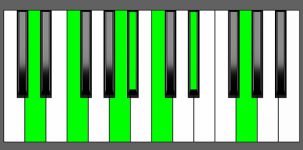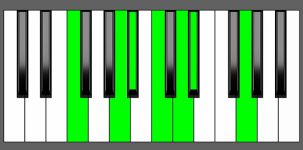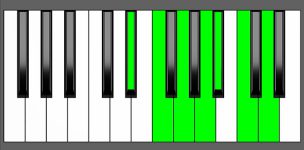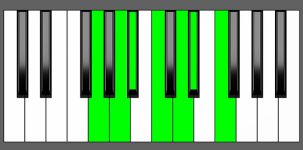Piano Diagram of Bb Maj13 in Root Position
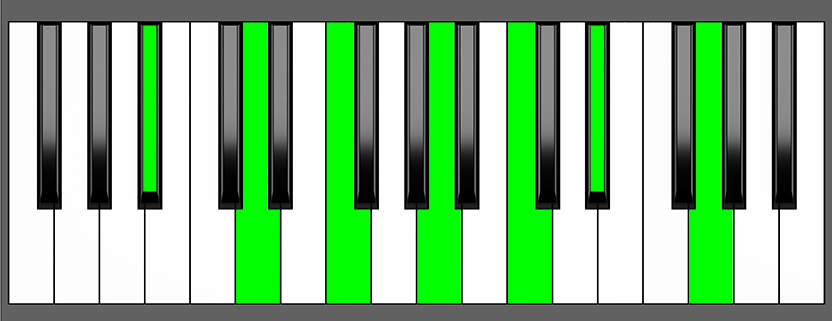
The Bb Maj13 is a chord that includes the root note Bb, a major third (D), a perfect fifth (F), a major seventh (A), a major ninth (C), an eleventh (Eb), and a 13th (G). It’s a diatonic extension of a Bb Maj7 chord with an extra layer of notes (9th, 11th, and 13th).
Structure of Bb Maj13
Notes |
|---|
| Bb, D, F, A, C, Eb, G |
Intervals |
|---|
| R, 3, 5, 7, 9, 11, 13 |
Playing Extended Chords on Piano
Extended chords are commonly used in piano playing, but they can be tricky to play in their entirety due to the large number of notes involved. To make these chords more manageable, pianists often omit certain notes, such as the root or the 5th. Another technique is to split the chord between both hands, playing either full or partial chords in each hand.
How to play a Bb Maj13
One approach to playing the Bb Maj13 chord is to begin by playing the root note Bb with your left hand then, with your right hand, you can play the minor 7th note A, the 9th note C, and the 13th note G.
Bb + A, C, G = Bb Maj13
This will result in a simplified Bb Maj13 chord that only includes the root note, major 7th, 9th, and 13th notes.
Alternatively, you can play the root note with your left hand and an inversion of the chord with the 7th note (A), the 3rd note (D), and the 13th note (G) with your right hand.
Bb + A, D, G = Bb Maj13
However, even when notes are omitted or split between hands, extended chords can still create complex and dense harmonies. When these chords are inverted, the resulting clusters of notes can be particularly challenging to voice effectively.
Bb Maj13 Chord Inversions
The Bb Maj13 chord has a total of 6 inversions:
| Root Position: | Bb | D | F | A | C | Eb | G |
| 1st Inversion: | D | F | A | Bb | C | Eb | G |
| 2nd Inversion: | F | A | Bb | C | D | Eb | G |
| 3rd Inversion: | A | Bb | C | D | Eb | F | G |
| 4th Inversion: | C | D | Eb | F | G | A | Bb |
| 5th Inversion | Eb | F | G | A | Bb | C | D |
| 6th Inversion | G | A | Bb | C | D | Eb | F |
Piano Keyboard Diagrams
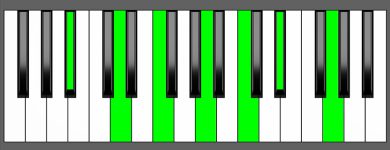
Chord Inversions on Piano
Understanding chord inversions is an essential aspect of music theory as it helps to explain how chords are arranged. When playing chord inversions on a piano, it’s important to keep in mind that the diagrams used to illustrate the order of notes may not always be practical or even possible to play.
To achieve the proper chord voicings on a piano, you need to distribute the notes of the chord across various octaves and positions on the keyboard. This often means that the basic shape of the chord’s inversions shown in diagrams may not be the most convenient or comfortable way to play the chord.
While chord inversion diagrams can be useful in comprehending the structure and sequence of notes in a chord, it’s always a good idea to try out different voicings and fingerings to discover the most efficient and comfortable way to play the chord, while still maintaining its intended harmonic function and sound.
Music Theory and Harmony of Bb Maj13
The Bb Maj13 chord is a natural extension of the Bb Maj7 chord, and it can serve as a variation or substitution for the latter.
Alternatively, it can be used as part of a modulation that resolves to a more stable Bb chord.
Essentially, the Bb Maj13 chord can be played in any position where the Bb Maj7 chord is used, but it is particularly useful when played in combination with it. However, it’s important to note that some positions may not work as well as others when using Bb Maj13 instead of Bb Maj7.
Building the Bb Maj13 Chord: Different Approaches
Starting from the Bb Major Scale
To form a Maj13 chord, you combine the root, the major 3rd, the 5th, the major 7th, the major 9th, the 11th, and the 13th from a major scale. To build a Bb Maj13, you can start with the Bb Major scale:


To create a Bb Maj13 chord, apply the formula R, 3, 5, 7, 9, 11, 13 in the following way:
- Begin with the Root note, which is Bb.
- Select the major 3rd interval, which is D, and add it to the chord.
- Add the 5th interval, F.
- Add the major 7th interval, A.
- Add the major 9th which is C.
- Add the 11th Eb, which is a 4th interval at the higher octave.
- Lastly, add the 13th (G) which is also a 6th at a higher octave.
By following this simple formula, you can create a 13th chord from any major scale.
by Combining Intervals
One method to create a major 13th chord is by combining specific intervals – a major 3rd, a minor 3rd, a major 3rd, a minor 3rd, again a minor 3rd, and finally a major 3rd. This is the formula:
3 + m3 + 3 + m3 + m3 + 3 = Major 13th Chords
Upon analysis of the Bb Maj13 chord, we can note that:
- the interval between Bb and D is a major 3rd,
- between D and F is a minor 3rd,
- between F and A is a major 3rd,
- between A and C is a minor 3rd,
- between C and Eb there is a minor 3rd,
- and finally, between Eb and G there is a major 3rd.
by Combining Chords
Another way to build major 13th chords is by combining a major triad with a diminished 7th chord derived from its major 7th, or by merging a major 7th chord with a minor triad that is based on its second interval.
To build a Bb Maj13 chord, you can blend a Bb Major triad (Bb, D, F) with an A dim7 chord (A, C, Eb, G) or a Bb Maj7 (Bb, D, F, A) with a C minor (C, Eb, G).
Bb Major + A dim7 = Bb Maj13
or
Bb Maj7 + C min = Bb Maj13
How to Use Bb Maj13 in a Chord Progression
The Bb Maj13 chord is essentially an extension of the Bb Maj7 chord, with the addition of the 9th (C), the 11th (Eb), and the 13th (G) note. These extra notes add a lot of dissonance and tension to the chord, which can make it tricky to use in a chord progression. Even if you leave out some of the notes, you still need to find the right voicing, because the effect of the Bb Maj13 depends on how it fits in with the other chords.
In this post, we will focus just on the most common uses of the Bb Maj13 chord. The tables of the major and natural minor scales below include the Bb minor 7th chord, which can be substituted or complemented by a Bb minor 13th chord.
Non-diatonic positions in D minor and F Major
It’s important to note that the 11th note of the chord (Eb) clashes with the E note found in both the F major and D minor scales, as they are only a half step apart. As a result, it’s generally recommended to avoid using a Bb major 13th chord in these particular positions.
However, rather than simply telling you to avoid it altogether, I believe the best approach is to test the dissonance of the Bb Maj13 chord in those positions and make a judgment call based on your preferences.
on Major Scales
| Major Scales | I | ii | iii | IV | V | vi | vii |
|---|---|---|---|---|---|---|---|
| Bb | Bb Maj7 ⇒ Bb Maj13 | C min7 | D min7 | Eb Maj7 | F7 | G min7 | Am7b5 |
| F | F Maj7 | G min7 | A min7 | Bb Maj7 ⇒ Bb Maj13 | C7 | D min7 | Em7b5 |
- Tonic chord in Bb Major
- Subdominant chord in F Major
on Natural minor Scales
| Minor Scales | i | ii | III | iv | v | VI | VII |
|---|---|---|---|---|---|---|---|
| G | G min7 | Am7b5 | Bb Maj7 ⇒ Bb Maj13 | C min7 | D min7 | Eb Maj7 | F7 |
| D | D min7 | Em7b5 | F Maj7 | G min7 | A min7 | Bb Maj7 ⇒ Bb Maj13 | C7 |
- Mediant chord in G minor
- Submediant chord in D minor
Bb Maj13 Chord Function in Major and Minor Keys
Understanding Scale Degrees
When we create chords based on a scale, each note is assigned a degree that reflects its position within the scale. These degrees act as a map to help us navigate the harmonic landscape of music.
- Beginning with the first degree of a musical scale, the Tonic chord is constructed on the first note of the scale, and it establishes the key center of the music, providing stability and grounding for the music.
- Moving to the second degree, the Supertonic chord is built on the second note of the scale and functions as a bridge between the Tonic and other chords in the scale, generating a sense of forward movement and tension.
- The third degree is the Mediant chord, built on the third note of the scale. It determines the mode of the scale (major or minor) and affects the emotional character of the music.
- The fourth degree is the Subdominant chord, constructed on the fourth note of the scale. It adds complexity to the music by creating tension and release.
- The fifth degree is the Dominant chord, built on the fifth note of the scale. It generates tension and anticipation and usually resolves back to the Tonic, giving the music a sense of closure.
- Moving on to the sixth degree, the Submediant chord is built on the sixth note of the scale, creating a feeling of relaxation and stability. It acts as a transition between the Dominant and Tonic chords, balancing and resolving the music.
- Lastly, the Leading tone chord is built on the seventh degree of the scale, generating tension and dissonance. It typically resolves to the Tonic, providing a sense of finality to the music.
Bb Maj13 as the Tonic Chord in Bb Major
A major 13th chord could be used in place of the first chord in the harmonized Bb major scale.
In a major key, the I chord (built on the first degree of the major scale) serves as the tonic chord, providing the harmonic center of the chord progression. If we take the Bb major scale and harmonize it using the notes of the scale, we get the following chords:
| I | ii | iii | IV | V | vi | vii |
| Bb Maj7 | C min7 | D min7 | Eb Maj7 | F7 | G min7 | Am7b5 |
Bb Maj13 Chord Progressions as I degree
Try playing these chord progressions to get an idea of how Bb Maj13 functions as the tonic (I degree) in a chord progression.
II V I
| ii | V | I |
| C min7 | F7 | Bb Maj13 | Bb Maj7
Bb (A, C, G) | Bb (A, D, F) |
One possible way to voice the Bb Maj13 chord is to play the root note Bb with your left hand and the notes A (major 7th), C (9th), and G (13th) with your right hand. Similarly, for the Bb Maj7 chord, you can play the root note Bb with your left hand and the notes A, D, and F with your right hand.
I IV V
| I | IV | V |
| Bb Maj13 | Bb Maj7 | Eb Maj7 | F7 |
I V vi IV
| I | V | vi | IV |
| Bb Maj13 | Bb Maj7 | F7 | G min7 | Eb Maj7 |
I IV vi V
| I | IV | vi | V |
| Bb Maj13 | Bb Maj7 | Eb Maj7 | G min7 | F7 |
Bb Maj13 as Subdominant Chord in F Major (Non diatonic)
Note that the 11th interval Eb may clash with the E note found in the F major scale, as they are a half step apart.
| I | ii | iii | IV | V | vi | vii |
| F Maj7 | G min7 | A min7 | Bb Maj7 | C7 | D min7 | Em7b5 |
Bb Maj13 as IV degree – Chord Progressions
Try playing these chord progressions to get an idea of how Bb Maj13 functions as the subdominant (IV degree) in a chord progression. I recommend omitting the 11th, but you can still experiment with using it for a dissonant modulation or a particular effect.
I IV V
| I | IV | V |
| F Maj7 | Bb Maj13 | Bb Maj7 | C7 |
I V vi IV
| I | V | vi | IV |
| F Maj7 | C7 | D min7 | Bb Maj13 | Bb Maj7 |
I IV vi V
| I | IV | vi | V |
| F Maj7 | Bb Maj13 | Bb Maj7 | D min7 | C7 |
Bb Maj13 as the Mediant Chord in G minor
Likewise, if we consider the G natural minor scale, we can use the Bb Maj13 chord on the third degree.
| i | ii | III | iv | v | VI | VII |
| G min7 | Am7b5 | Bb Maj7 | C min7 | D min7 | Eb Maj7 | F7 |
Bb Maj13 as III degree – Chord Progressions
These chord progressions can help you comprehend how Bb Maj13 serves as the mediant (III degree).
i III
| i | III |
| G min7 | Bb Maj13 | Bb Maj7 |
i III iv v
| i | III | iv | v |
| G min7 | Bb Maj13 | Bb Maj7 | C min7 | D min7 |
i III ii v
| i | III | ii | v |
| G min7 | Bb Maj13 | Bb Maj7 | Am7b5 | D min7 |
I iii vi V
| i | III | VI | iv |
| G min7 | Bb Maj13 | Bb Maj7 | Eb Maj7 | C min7 |
i III VII VI
| i | III | VII | VI |
| G min7 | Bb Maj13 | Bb Maj7 | F7 | Eb Maj7 |
Circle Progression
| i | iv | VII | III | VI | ii | V7 | i |
| G min7 | C min7 | F7 | Bb Maj13 | Bb Maj7 | Eb Maj7 | Am7b5 | D7 | G min7 |
Bb Maj13 as the Submediant Chord in D minor (Non diatonic)
In the key of D natural minor, using a Bb Maj13 chord as the submediant chord is considered non-diatonic due to the presence of the 11th note, Eb, which is a half-step away from the E note, the ii degree. It is recommended to avoid playing the 11th note in D minor when using this chord.
| i | ii | III | iv | v | VI | VII |
| D min7 | Em7b5 | F Maj7 | G min7 | A min7 | Bb Maj7 | C7 |
Bb Maj13 as VI degree – Chord Progressions
Try playing these chord progressions to get a sense of how Bb Maj13 sounds as the submediant (VI degree).
i VI VII
| i | VI | VII |
| D min7 | Bb Maj13 | Bb Maj7 | C7 |
i v VI VII
| i | v | VI | VII |
| D min7 | A min7 | Bb Maj13 | Bb Maj7 | C7 |
i III VII VI
| i | III | VII | VI |
| D min7 | F Maj7 | C7 | Bb Maj13 | Bb Maj7 |
Circle Progression
| i | iv | VII | III | VI | ii | V7 | i |
| D min7 | G min7 | C7 | F Maj7 | Bb Maj13 | Bb Maj7 | Em7b5 | A7 | D min7 |
Alternative Names for Bb Maj13 Chord
- Bb j13
- Bb ∆13
- Bb M13
- Bb ∆(13)
- Bb Ma13
- Bb maj13
- Bb Maj13
- Bb major 13
- Bb Maj7(13)
Conclusion
The chord progressions and examples presented in this post provide a comprehensive overview of the most common uses of the Bb Maj13 chord. It’s important to note, however, that many advanced harmony-related topics could not be included due to space constraints. These topics include chord progressions built on harmonic and melodic scales, modal scales, hidden tonality, secondary dominants and other chord substitutions, non-functional harmony and atonal music, modal interchange and borrowed chords, voice leading and counterpoint, chromatisms, jazz harmony…I mean, music theory is a huge topic!
Although I couldn’t cover all of these topics in my post, I encourage readers to continue exploring these areas in their own study and research. By expanding your knowledge in these advanced areas of music theory, you can gain a deeper understanding of the harmonic possibilities that exist beyond the basics presented here.
